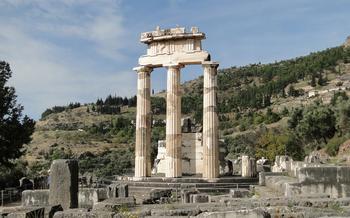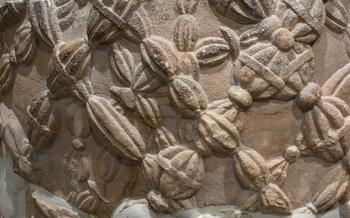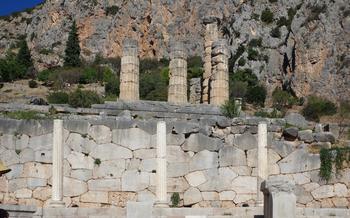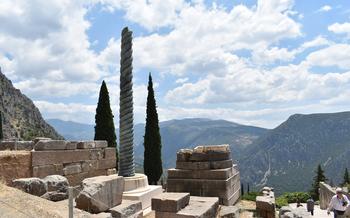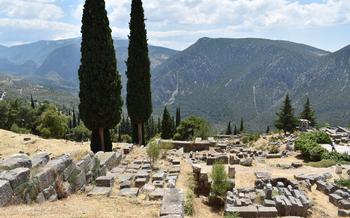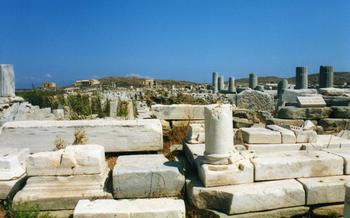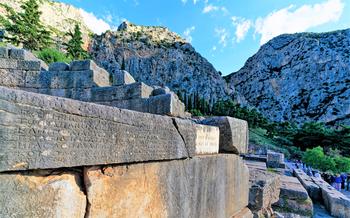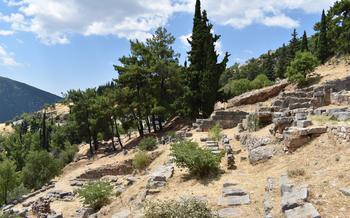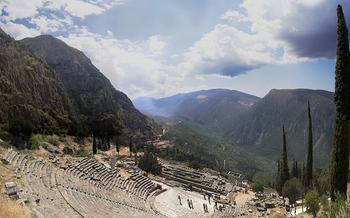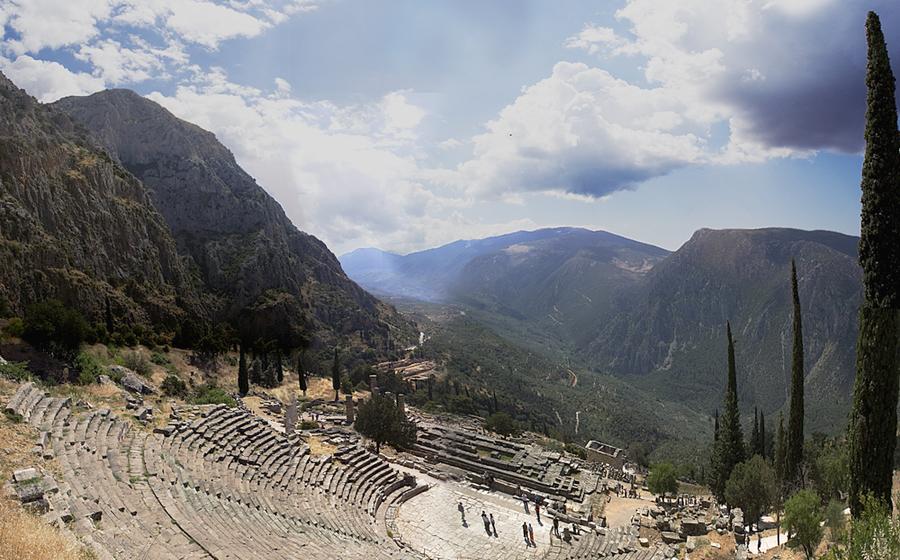
The Springs of Agoriani
- Delphi: A Realm of History and Mythology
- The Sanctuary of Apollo: Unveiling a Sacred Place
- The Temple of Apollo: A Masterpiece of Ancient Architecture
- The Tholos of Delphi: An Enigma of Circular Design
- The Castalian Spring: A Sacred Source of Inspiration
- The Treasury of Athens: A Monument to Athenian Supremacy
- The Treasury of the Siphnians: A Testament to Artistic Excellence
- The Polygonal Wall: A Fortification of Ancient Delphi
- The Museum of Delphi: A Treasury of Ancient Artifacts
- The Sacred Way: A Path of Pilgrimage and Processions
- The Theater of Delphi: A Venue for Ancient Performances
- The Stadium of Delphi: A Place of Athletic Contests
- The Modern Town of Delphi: A Base for Exploration
- Insider Tip: The Springs of Agoriani - A Hidden Gem
Delphi: A Realm of History and Mythology
Delphi stands as a testament to ancient Greece's rich history and vibrant mythology. Steeped in legend and lore, this sacred site played a pivotal role in shaping the spiritual and cultural landscape of the Hellenic world. According to Greek mythology, Delphi was the home of the Oracle of Apollo, a revered prophetess whose utterances were sought by rulers, statesmen, and ordinary people alike. The site's significance extended far beyond its religious importance, as it served as a hub for cultural exchange, artistic expression, and athletic competitions. Excavations have unearthed a wealth of archaeological treasures, including stunning temples, intricate sculptures, and awe-inspiring ruins, all of which paint a vivid picture of Delphi's former glory and enduring legacy.
The Sanctuary of Apollo: Unveiling a Sacred Place
The Sanctuary of Apollo, also known as the Oracle of Delphi, is one of the most significant and well-preserved archaeological sites in Greece. Located in the picturesque town of Delphi, the sanctuary was once an important religious and political center in the ancient world. It served as a place of worship, divination, and pilgrimage for people from all over Greece and beyond.
The sanctuary's origins date back to the 8th century BC when it was dedicated to the worship of Apollo, the god of prophecy and healing. Over time, it grew into a vast complex of temples, altars, treasuries, and other structures, each with its own unique purpose and significance. The layout of the sanctuary reflects the importance of the oracle, with the Temple of Apollo at its heart.
The temple, constructed in the 6th century BC, was considered one of the most sacred buildings in ancient Greece. It housed the oracle, a priestess known as the Pythia, who would deliver prophecies on behalf of Apollo. The Pythia's prophecies, often cryptic and ambiguous, were highly influential and played a vital role in decision-making throughout the ancient world.
In addition to the temple, the sanctuary also included other significant structures, such as the treasuries, which were built by various city-states to store their offerings to Apollo. The most notable among them is the Treasury of Athens, which stands out for its exquisite sculptures and architectural features.
The Sanctuary of Apollo was a place of immense spiritual and political significance in ancient Greece. It was a place where people sought guidance and wisdom from the gods, where important decisions were made, and where religious festivals and celebrations were held. Today, the ruins of the sanctuary stand as a testament to the power and influence of the oracle and offer a glimpse into the religious beliefs and practices of the ancient Greeks.
The Temple of Apollo: A Masterpiece of Ancient Architecture
Amidst the ruins of Delphi, the Temple of Apollo stands as a testament to the architectural prowess of ancient Greece. Constructed in the 6th century BC, the temple served as the focal point of the sanctuary and was dedicated to the god Apollo, the patron deity of Delphi. The temple's grandeur and intricate design reflect its significance as a place of worship, religious ceremonies, and the consultation of the oracle.
Built from local limestone, the temple exhibits a Doric architectural style characterized by its simplicity and harmonious proportions. Its rectangular shape is defined by a colonnade of six columns on each of the short sides and fifteen columns on each of the long sides, creating a majestic and imposing facade. The columns, adorned with delicate fluting, support a massive entablature featuring triglyphs and metopes, the latter of which were originally decorated with sculptures depicting mythological scenes.
Inside the temple, a cella divided into two chambers housed the cult statue of Apollo, a colossal bronze figure that has unfortunately been lost to time. The interior was adorned with intricate carvings and paintings, contributing to the temple's sacred and awe-inspiring atmosphere. The Temple of Apollo, with its architectural sophistication and religious significance, remains one of the most iconic landmarks of ancient Greece, captivating visitors with its enduring beauty and historical importance.
The Tholos of Delphi: An Enigma of Circular Design
Amidst the ruins of Delphi, the Tholos stands out as a unique and enigmatic structure. Erected in the 4th century BC, its circular shape and distinctive design have puzzled scholars and historians for centuries. The Tholos, also known as the Rotunda, is a marvel of ancient architecture, showcasing the ingenuity and creativity of the ancient Greeks.
Its circular form, unusual for Greek architecture of the time, has led to various interpretations and theories about its purpose. Some believe it was a treasury, storing valuable offerings made to the oracle or the sanctuary. Others suggest it served as a meeting place for religious or political gatherings.
The Tholos is adorned with intricate carvings and sculptures, adding to its allure. The exterior features a frieze depicting scenes from Greek mythology, including the battle between the gods and the giants. Its interior is equally captivating, with remnants of colorful frescoes and decorative elements.
Despite extensive research, the exact purpose of the Tholos remains shrouded in mystery. Its unique design and symbolic significance continue to captivate visitors and fuel the imagination of archaeologists and historians alike. The Tholos stands as a testament to the architectural prowess and creativity of the ancient Greeks, leaving an enduring legacy for future generations to explore and ponder.
The Castalian Spring: A Sacred Source of Inspiration
History and Significance
The Castalian Spring holds a revered position in Greek mythology and history. According to legend, the spring was created by the god Apollo when he slew the serpent Python and claimed the oracle at Delphi as his own. From that moment, the spring's waters were imbued with divine power and became a sacred source of inspiration and purification for those seeking guidance from the oracle.
Mythological Associations
In ancient Greek mythology, the Castalian Spring was closely linked to the Muses, the nine daughters of Zeus and Mnemosyne, the goddess of memory. It was believed that the Muses bathed in the spring's waters, which granted them their divine inspiration and poetic abilities. Poets, musicians, and artists would often visit the spring to seek the Muses' favor and enhance their creative talents.
Rituals and Purification Ceremonies
The Castalian Spring played a crucial role in the rituals and purification ceremonies associated with the Oracle of Delphi. Before consulting the oracle, visitors were required to undergo a ritual cleansing by bathing in the spring's sacred waters. This purification ritual symbolized the shedding of impurities and the readiness to receive divine guidance from the oracle.
Healing Properties
In addition to its spiritual significance, the Castalian Spring was also believed to possess healing properties. The ancient Greeks attributed various medicinal qualities to the spring's waters, including the ability to cure diseases, restore vigor, and promote overall well-being. Many visitors to Delphi would drink from the spring or bathe in its waters in the hope of finding relief from their ailments.
The Treasury of Athens: A Monument to Athenian Supremacy
Amidst the architectural wonders of Delphi, the Treasury of Athens stands as a testament to the city-state's wealth, power, and cultural influence. Built in the 5th century BC, this treasury was a symbolic representation of Athenian supremacy and a display of their artistic prowess. The treasury's facade features intricate Doric columns and a triangular pediment adorned with sculptures depicting scenes from the Battle of Marathon, where the Athenians emerged victorious against the invading Persian army. Inside the treasury, visitors can admire the well-preserved frescoes that depict mythological scenes, offering a glimpse into the rich tapestry of ancient Greek storytelling. This treasury serves as a reminder of Athens' significant contributions to the cultural and political landscape of ancient Greece, showcasing the city-state's pride and accomplishments.
The Treasury of the Siphnians: A Testament to Artistic Excellence
Among the many impressive structures at Delphi, the Treasury of the Siphnians stands out as a testament to artistic excellence. Constructed in the 6th century BC by the wealthy and powerful island of Siphnos, this treasury showcases exquisite sculptures and intricate reliefs that depict mythological scenes with remarkable detail and finesse.
The treasury's exterior is adorned with a continuous frieze depicting the Trojan War, the Battle of the Gods and Giants, and other mythological tales. The figures are carved with precision and grace, capturing the essence of movement and emotion. The intricate details of their clothing, armor, and facial expressions bring the stories to life.
Inside the treasury, visitors can admire a series of sculptures that depict the Siphnians themselves, presenting offerings to the gods. These figures are notable for their realistic portrayal and individuality, suggesting that the Siphnians took great pride in their appearance and accomplishments.
The Treasury of the Siphnians is not only a marvel of ancient architecture but also a testament to the artistic prowess and creativity of the Siphnians. It provides valuable insights into ancient Greek mythology and storytelling, offering a glimpse into the beliefs and values of this remarkable civilization.
The Polygonal Wall: A Fortification of Ancient Delphi
The Polygonal Wall, a remarkable feat of ancient engineering, stands as a testament to the defensive prowess of Delphi. Constructed using a unique technique, the wall's massive stones were fitted together without the use of mortar, creating a formidable barrier that protected the sacred site from potential invaders. Its strategic positioning ensured that Delphi remained impregnable, a sanctuary shielded from harm.
The Polygonal Wall's construction showcased the ingenuity and architectural skills of the ancient Greeks. The massive stones, some weighing several tons, were carefully shaped and arranged to form a sturdy and impenetrable structure. The wall's polygonal shape provided additional strength, preventing attackers from gaining a foothold or scaling its height.
The wall's impressive preservation serves as a reminder of Delphi's enduring legacy. Despite the passage of time and various natural calamities, the Polygonal Wall remains largely intact, a testament to the enduring craftsmanship of its builders. Its presence adds to the allure of Delphi, inviting visitors to marvel at the defensive prowess of this ancient city.
The Museum of Delphi: A Treasury of Ancient Artifacts
Established in the early 20th century, the Museum of Delphi stands as a testament to the rich cultural and historical heritage of ancient Greece. Over the years, the museum has amassed an extensive collection of artifacts excavated from the archaeological site, offering visitors a captivating glimpse into the daily life, culture, and beliefs of the ancient Greeks.
Within the museum's walls, visitors can marvel at an array of sculptures, pottery, jewelry, inscriptions, and other precious relics. Among the highlights are the famous bronze statue of the Charioteer of Delphi, a masterpiece of ancient Greek sculpture, and the enigmatic Sphinx of Naxos, with its haunting gaze. These artifacts provide a tangible connection to the artistry, craftsmanship, and mythology of the ancient world.
The museum also houses a wealth of inscriptions, offering insights into the political, economic, and religious life of Delphi. These inscriptions range from decrees and treaties to dedications and oracles, shedding light on the intricate workings of ancient Greek society.
A visit to the Museum of Delphi is an essential part of any journey to this sacred site. It provides a deeper understanding of the significance of Delphi in ancient Greece and allows visitors to appreciate the artistic and cultural achievements of this remarkable civilization.
The Sacred Way: A Path of Pilgrimage and Processions
The Sacred Way, also known as the Via Sacra, was a significant path in ancient Delphi. Stretching from the Sanctuary of Apollo to the Temple of Athena Pronaia, it served as a ceremonial route for religious processions and festivals. Pilgrims and worshippers would walk along this sacred path, offering prayers and participating in rituals as they made their way to the temple.
The Sacred Way was lined with numerous monuments, statues, and treasuries, each dedicated to a specific deity or city-state. These structures showcased the wealth and artistry of the ancient Greeks, adding to the grandeur of the sacred path.
During religious festivals, such as the Pythian Games, the Sacred Way would come alive with processions and ceremonies. Chariots carrying statues of gods and goddesses were paraded along the path, accompanied by music, dancing, and chanting. These processions were a spectacle of devotion and celebration, honoring the sacred nature of Delphi.
Walking along the Sacred Way today, visitors can still sense the spiritual significance of this ancient path. The ruins of temples, treasuries, and monuments stand as reminders of the religious fervor that once filled this space. By tracing the steps of ancient pilgrims, visitors can gain a deeper understanding of the sacred rituals and beliefs that shaped ancient Greek culture.
The Theater of Delphi: A Venue for Ancient Performances
Amidst the ruins of Delphi, the Theater of Delphi stands as a testament to the significance of performing arts in ancient Greek culture. Constructed in the 4th century BC, the theater is a remarkable example of ancient architecture and engineering, designed to host a variety of performances, including plays, musical concerts, and religious rituals.
With a seating capacity of approximately 5,000 spectators, the theater is built on a hillside, providing a breathtaking view of the surrounding landscape. The stage, which is in excellent condition, features a backdrop of elaborate architectural elements, including columns, niches, and statues, adding to the overall grandeur of the theater.
The acoustics of the theater are exceptional, allowing performers' voices to carry effortlessly throughout the auditorium. This remarkable acoustic quality made the theater an ideal venue for dramatic performances, where actors could engage with the audience and convey emotions effectively.
The Theater of Delphi served as a central location for various religious festivals, including the Pythian Games, which were held every four years in honor of Apollo. During these festivals, the theater hosted musical competitions, poetry recitals, and theatrical performances that celebrated Greek mythology and culture.
Beyond its religious significance, the theater also played a vital role in the social and cultural life of Delphi. It provided a platform for the exchange of ideas, entertainment, and artistic expression, contributing to the city's reputation as a center of intellectual and cultural pursuits.
Today, the Theater of Delphi remains a popular attraction for visitors, who can experience the awe-inspiring acoustics and imagine the vibrant atmosphere of ancient performances that once filled this space.
The Stadium of Delphi: A Place of Athletic Contests
The Stadium of Delphi, situated on a hillside overlooking the sanctuary of Apollo, served as an integral part of the ancient sporting competitions held during religious festivals. Built in the 5th century BC, this impressive structure showcased the significance of physical prowess and athleticism in ancient Greek culture. The stadium's elongated U-shape, with tiered seating carved into the natural slope, provided ample space for spectators to witness the thrilling contests. Athletes competed in various disciplines, including footraces of different distances, wrestling, and the pentathlon, a grueling combination of five events: discus throw, javelin throw, long jump, stadion race, and wrestling. The victors were celebrated and honored, their triumphs immortalized in inscriptions and statues that adorned the stadium. Witnessing these ancient sporting events would have been a captivating spectacle, showcasing the athleticism, determination, and competitive spirit of the ancient Greeks.
The Modern Town of Delphi: A Base for Exploration
Nestled amidst the picturesque landscapes of Central Greece, the modern town of Delphi serves as a welcoming gateway for travelers to explore the ancient wonders of the region. Whether you seek comfortable accommodation, delectable dining experiences, or convenient transportation options, Delphi has it all. Immerse yourself in the local culture by attending traditional festivals and engaging in vibrant events that showcase the rich heritage of the area. Don't miss the chance to embark on invigorating hikes or leisurely nature walks, where breathtaking scenic views await at every turn. Delphi seamlessly blends the allure of ancient history with modern-day comforts, offering a truly unforgettable travel experience.
Insider Tip: The Springs of Agoriani - A Hidden Gem
Beyond the realm of ancient ruins and historical wonders, Delphi holds a secret gem that offers a unique blend of relaxation and exploration - the Springs of Agoriani. Located just a short distance from the main archaeological site, these natural hot springs are a hidden oasis that invites you to unwind and rejuvenate in a tranquil setting.
Easily accessible by foot or by car, the Springs of Agoriani are nestled amidst lush greenery, creating a secluded haven away from the hustle and bustle of the tourist crowds. As you approach the springs, the sound of gently flowing water and the scent of fresh air create a sense of serenity that envelops you.
The springs themselves are a series of small pools, each varying in temperature and offering a unique bathing experience. Immerse yourself in the warm, mineral-rich waters and let your worries melt away as you soak in the tranquility of your surroundings. The natural setting, with its verdant foliage and the sound of birdsong, enhances the rejuvenating experience.
Whether you seek relaxation, healing, or simply a moment of peace, the Springs of Agoriani offer a welcome respite from exploring the ancient wonders of Delphi. Take a break from your historical journey to indulge in the restorative powers of nature's hot springs and return to your explorations refreshed and revitalized.
